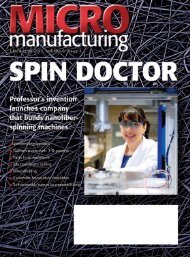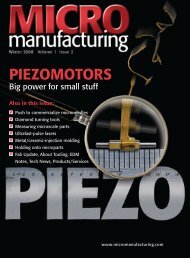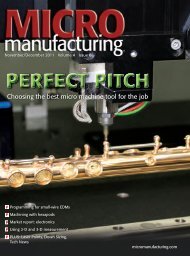to view as PDF - MICROmanufacturing
to view as PDF - MICROmanufacturing
to view as PDF - MICROmanufacturing
You also want an ePaper? Increase the reach of your titles
YUMPU automatically turns print PDFs into web optimized ePapers that Google loves.
DOWNsizing<br />
Silicon that goes pitter pat<br />
18 | MAY/JUNE 2012 | <strong>MICROmanufacturing</strong><br />
Siemens<br />
Doc<strong>to</strong>rs used an empty shoe polish tin <strong>to</strong> enc<strong>as</strong>e the first implantable pacemaker in epoxy resin. The<br />
device (similar <strong>to</strong> the one pictured above) only l<strong>as</strong>ted a few hours before it had <strong>to</strong> be replaced.<br />
Though implantable pacemakers now<br />
come in models <strong>as</strong> small <strong>as</strong> a half dollar,<br />
rampant talk on the Internet promises a<br />
future with devices that offer an exponential<br />
reduction in size and cost—not <strong>to</strong> mention<br />
reduced risk of infection.<br />
To be sure, <strong>to</strong>day’s pacemaker options<br />
are dwarfed by the first such device ever<br />
implanted. That Siemens-Elema pacemaker,<br />
implanted in 1958, w<strong>as</strong> the size of a shoe<br />
polish tin.<br />
The analogy isn’t <strong>as</strong> random <strong>as</strong> you<br />
might think. Swedish developers Dr. Rune<br />
Elmqvist, a physician working <strong>as</strong> an engineer<br />
for Siemens-Elema, and Dr. Åke Senning, a<br />
cardiologist and professor at the Korolinska<br />
Hospital in S<strong>to</strong>ckholm, <strong>to</strong>ok advantage of<br />
emerging silicon technology <strong>to</strong> develop a<br />
pacemaker small enough <strong>to</strong> be implanted.<br />
Once <strong>as</strong>sembled, they used an empty shoe<br />
polish tin <strong>to</strong> enc<strong>as</strong>e all the components of the<br />
pacemaker within epoxy resin.<br />
During “a secret emergency operation on<br />
Oct. 8, 1958,” the device w<strong>as</strong> implanted in<strong>to</strong><br />
43-year-old Arne Larsson, who w<strong>as</strong> suffering<br />
from a life-threatening cardiac arrhythmia,<br />
according <strong>to</strong> a Web-b<strong>as</strong>ed his<strong>to</strong>rical account<br />
from Siemens AG, Munich.<br />
As crude <strong>as</strong> such ingenuity may seem<br />
<strong>to</strong>day, there’s no need <strong>to</strong> feel sorry for<br />
Larsson; he went on <strong>to</strong> enjoy an active<br />
lifestyle, outliving even the men who saved<br />
his life—Elmqvist and Senning. Larsson is<br />
said <strong>to</strong> have had 26 pacemakers implanted<br />
before his death in 2001 at age 86.<br />
While Larsson’s first pacemaker used<br />
just two transis<strong>to</strong>rs, pacemakers <strong>to</strong>day<br />
incorporate microprocessors with billions of<br />
transis<strong>to</strong>rs. In fact, the programmable devices<br />
are capable of wireless communications that<br />
enable physicians <strong>to</strong> remotely moni<strong>to</strong>r the<br />
pacemakers and their patients.<br />
For example, the Ingenio family of<br />
pacemakers, launched in the European















